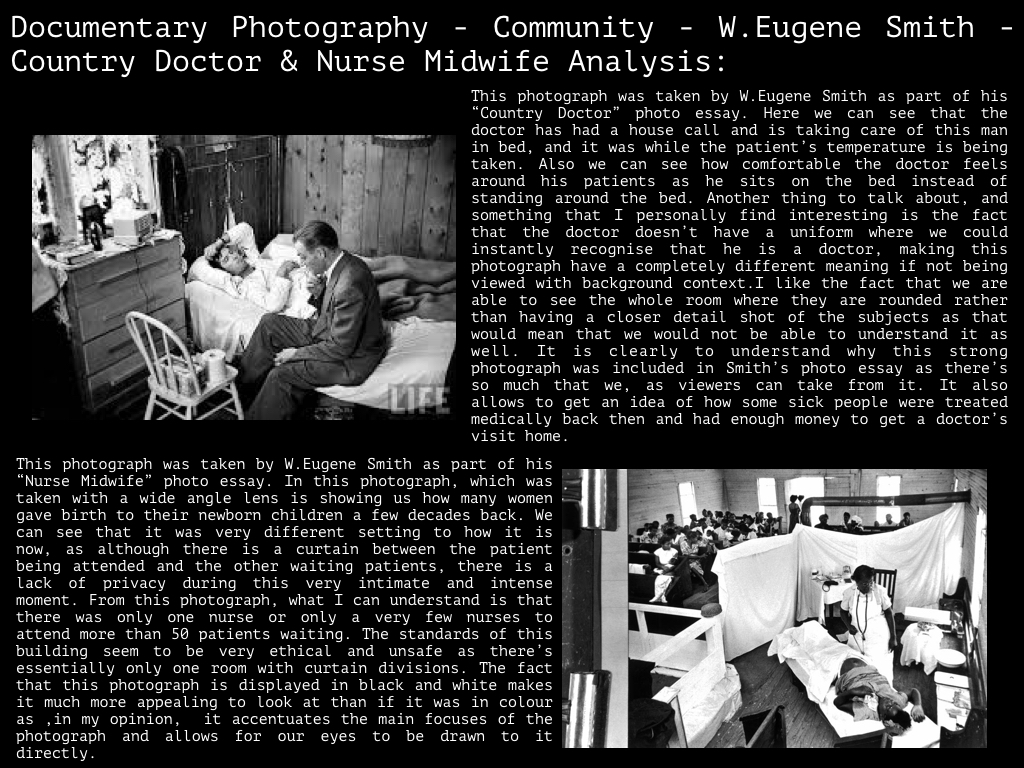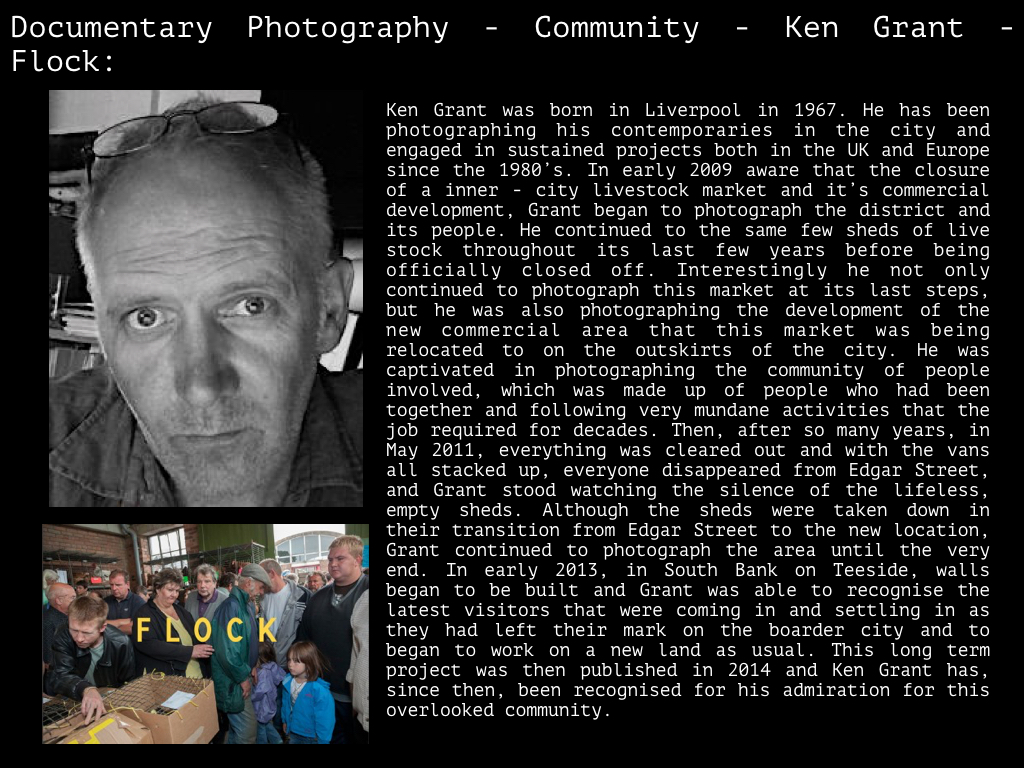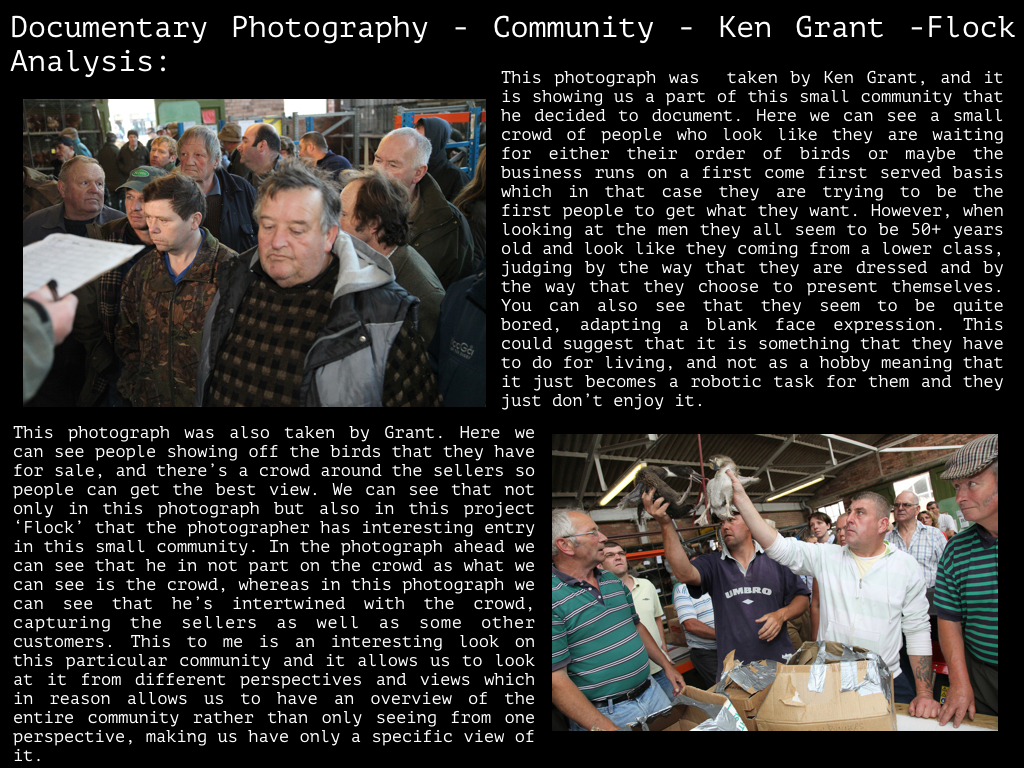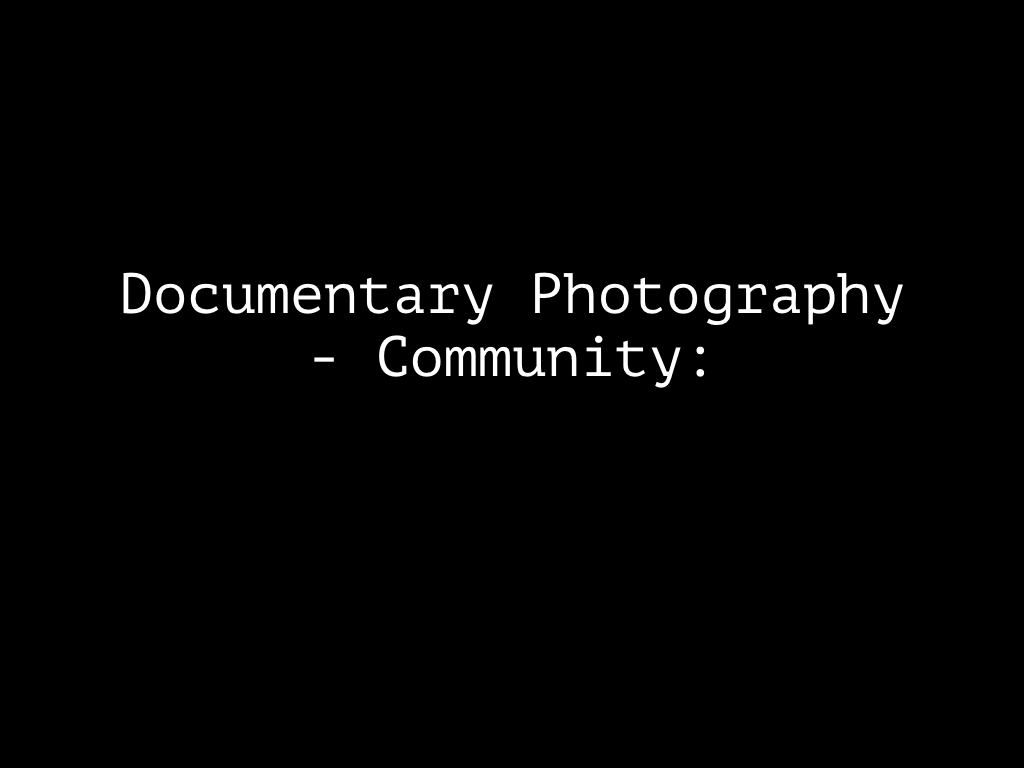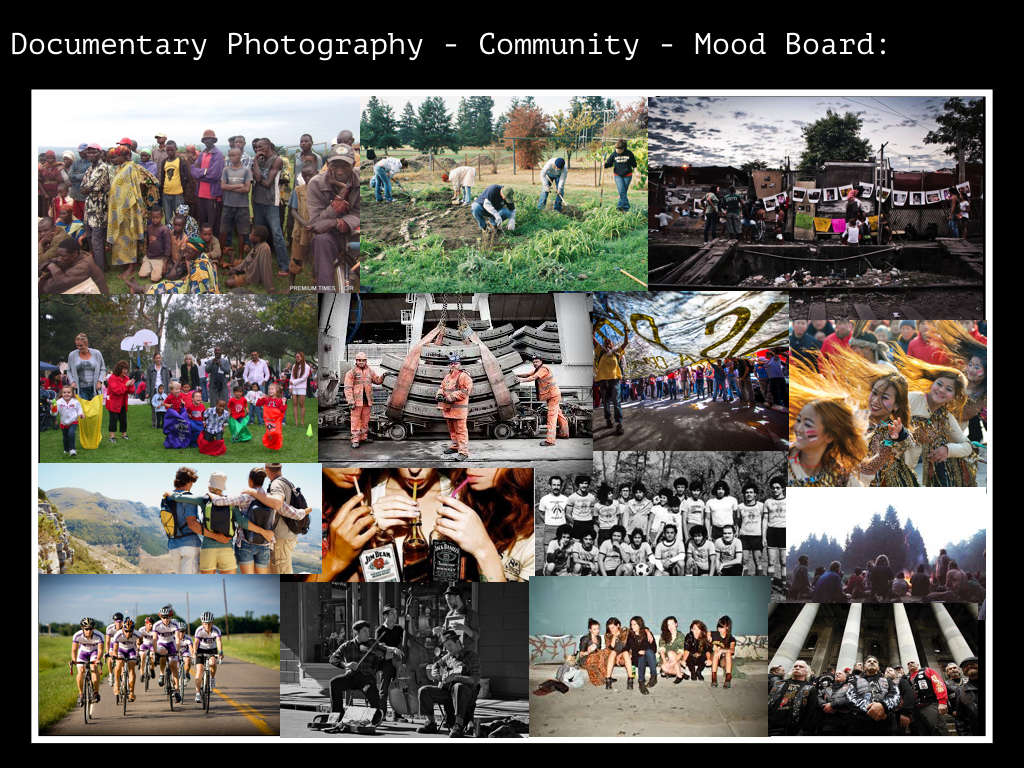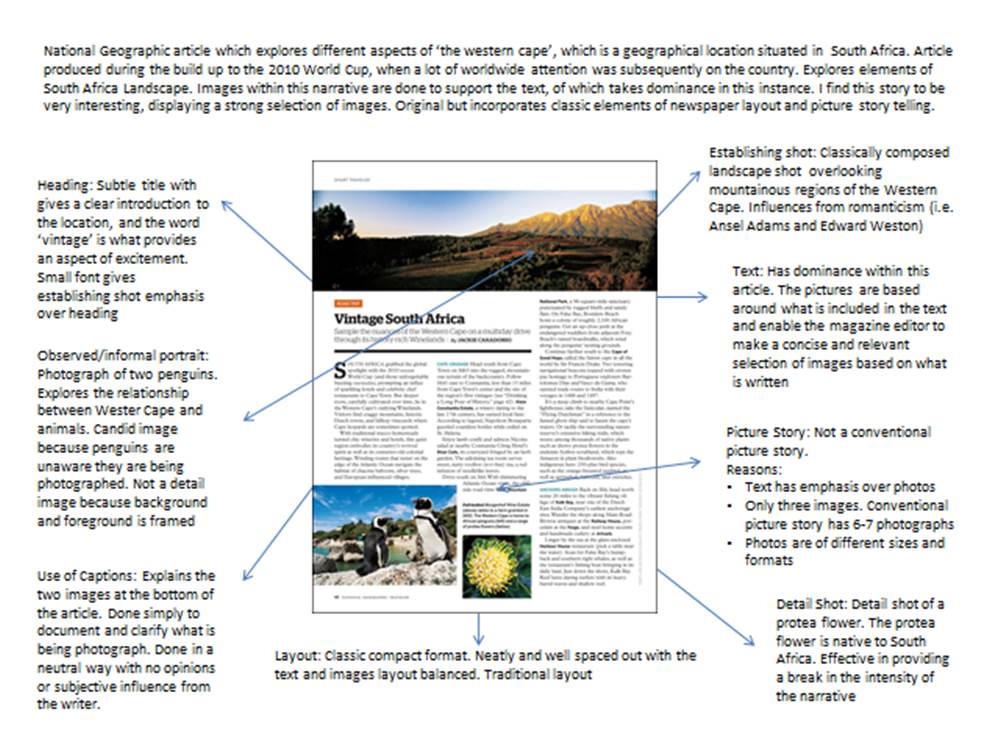Category Archives: Analysis
Filters
DOCUMENTARY PHOTOGRAPHY – COMMUNITY – ARTIST:
DOCUMENTARY PHOTOGRAPHY – COMMUNITY:
Vernacular Photography
Background and History
Vernacular Photography is a style of photography which appears ‘amateur’, but done so in a well considered way by the photographer. Vernacular photographers deliberately attempt to photograph subjects and landscape in a ‘snap-shot’ style manner, whilst deliberately altering the white balance of the image to give in an old retro feel.
The avant-garde art movement of the 20th century, began to recognize the context of art oppose to merely its aesthetics form. This started to change the way individuals viewed art. Avant-garde is a movement which has inspired a range of art movements throughout the 20th century – including surrealism, dadaism and pop-art, as well as art movements in the early 21st century including ‘brit-art’. Avant-gardve as an artistic form is controversial because it constantly tested how society views what art is.
Classic landscape photographers such as Edward Weston and Ansel Adams made their photographs based on the concept of formalism which was linked to the romanticism movement. Their images were all based on good form and composition. Weston’s intricate close-ups and Adams stunning and inspiring landscape shots, helped to set the bench-mark for photography and defined what made a good photograph. Photographers such as William Klein, who produced grainy, blurred images of 1950s New York, began to re-define what photography was. As society slowly became used to the concept of photography as something much more than pretty, romanticized images, avant-garde photographers began to test this definition more and more, which photographers such as Stephen Shore and William Eggleston, pioneering a completely new style of landscape photography, ‘new topography’.
Although Vernacular photography as a concept has existed since 1940s, it is often a very undervalued and under appreciated artistic style. It has inspired the work off many revolutionary photographers such as Walker Evans. In 1996, the work of Richard Billingham in ‘Ray’s a Laugh’ began to recognition of vernacular photography as a serious form of art in its own right. The photographs in Billingham’s book consist of snap-shot styled images. The actual form and composition of the images are terrible, however they reflect such a deep and personal story in a way which is dark and authentic. It was Billingham’s work in which people started to take seriously the concept of ‘vernacular photography’.
What actually is vernacular photography?
Vernacular photography is any type of photography which is considered to be amateurism, whether through intent or by accident. Family snap-shot taken by amateur photographers are considered the most popular form of vernacular photography, and the retro style of these shots is what has inspired the format. It is very difficult for a trained photographer to take vernacular styled image but it requires a complete dismissal of form and composition. Taking a powerful and well consider vernacular photograph is therefore extremely difficult to achieve.
The style of vernacular photograph are very snapshot styled. The color balance of the photographs are often made to look ‘greenish’ as they would with old Polaroid snap. Motion blur is also a common theme of this type of photography.



Inspiration
I first became interested in the concept of venacular photography through looking at some of my music album covers. The covers of the Stereophonic’s ‘You Gotta Go There to Come Back’, Oaisis’s ‘Heathen Chemistry’ and Jake Bugg’s self titled ‘Jake Bugg’, all use vernacular styled images.

I have looked at the work of Richard Billigham (Ray’s a Laugh), Martin Parr (Think of England) and Tom Hunter (Le Crowbar). Here are a few images from Tom Hunter’s series ‘Le Crowbar’.


Reflection
For the start of this project I have started to explore Vernacular photography in my own work. I felt this style was interesting to explore. For this project I want to create subtle form of vernacular images, meaning that the images I create will be classically composed images with considered lighting and form, however I will incorporate vernacular techniques to give my images a slight ‘edge’, making them more interesting then just simply classically composed ‘clean’ looking images.
Picture Story: Analysis and Deconstruction
Picture Story: Mood Board Layout
finals from church shoot
These are the final four images that I have chosen from my grandparents shoot at their local church. I haven’t had time to edit these images yet, but when I do I would like to edit the lighting as some of the images have a yellow/orange tinge.
This is a photograph of the main feature of the church. The stain glass window was put in, in the year 2000 when the church was refurbished. It was donated by Mourant and Jeune Families. The master piece was created by Neil Mckenzie who as well as being a stain glass window artist is also a great lover of Boarder collies. Neil includes them in everyone of his stain glass window creations.
I really love this stain Glass window because it is the main statement in the church, and everything else inside the building is positioned around it. It involves a great about of bold beautiful colours that are very eye catching. My favourite colour on the window is the purple, because when it is a sunny morning it catches the light and creates a beautiful colour.
This candle is in the main area of the church and is lit every service. my Grandma is usually the person to light the candle as she arrives an hour before the service to prepare the church. The candle represents Jesus being the light of the world, I like that everything in a church has a meaning or a representation behind it. I think it makes everything more interesting and intriguing.
I think this is a powerful image because of the light of the candle reflecting in my Grandma’s glasses, especially because of the strong meaning behind the lit candle. Also the wooden cross in the background of the photograph.
This is my portrait of Rev. Graeme Halls, that I took this Sunday. He usually takes the GeorgeTown services however this weekend he was taking the remembrance celebration at Cenotaph. His wife, Elaine, made him his stole especially for this occasion. The stole is so beautiful and includes so many bright colours which are very attractive to look at.
I like how Graeme is positioned, he has a very straight posture, which makes him very welcoming and nice to photograph. His hands are positioned in front of him, in a very natural way and his face is smiling, but not at the camera.
This is the last photograph from my finals from my church shoot. It is of my Grandpa who is changing into his organ shoes. It is a strong image because it is an action shot, and you can see the movement in the left foot. He is positioned directly in the middle of the image with the leading lines from the steps leading the eye toward him. He is also the darkest thing in the photograph, therefore the eye is attracted straight to him. There is a poppy display to the right of him which is a bold object to have in an image.
Photo shoot of Community Member:
As we departed for half-term, I began to take some general photographs of themes like: street photography, portraiture and environmental shots.
Whilst I was in a cafe with family and friends, we came across a familiar man. The family friend had been a customer where my mum had worked for many decades and everyone grew to know him well.
The thing that struck me about him was his strong character. Although he was suffering through a very difficult condition he still managed to smile through it and enjoy himself. His uplifting demeanor and happy attitude was refreshing.
I then respectfully asked him if I could take some pictures and he agreed to let me. I instructed him to stand outside the cafe whilst I tried out several shots and angles. However, I didn’t instruct him to pose or stand which he did naturally.
Here are my edited outcomes from this shoot:
This was the first shot that I took. I wanted to capture his device which he must carry around with him in order to breathe properly. I tinted the image into light blue. Blue is a cool color so I think that it made the mood gloomy which is what I wanted.
This picture below is both an establishing shot and a portrait. It involves the man’s body and environment.
I then took a side shot, because I wanted to incorporate a full-body shot.
As the family friend was looking away I captured this. In the distance, a greatly-timed cyclist appeared.
I think that the photography below is very striking. The man ‘s expression is very strong and he seems to be very concentrated.
I experimented with various colors whilst editing. Firstly black and white and then a purple solid color.
As another experiment, I did the same to these one’s except with the shades of grey and blue.
This is my favorite image. I changed it into black and white to demonstrate the intensity of the contrasting shades. He is looking directly into the camera with sharp eyes and a great presence. The look seems very real and the fact that he isn’t smiling is even better. This is because smiles tend to hide the truth about how someone’s feeling, so this is good to imagine.
CASE STUDY: ATLANTUS – A TRANSOCEANIC JOURNEY
Atlantus is “a visual and oral exchange of cultures , histories and identities”, this was a project that was done in Jersey and New Jersey to see the connection between the two. This project was between Martin Toft and Archisle. The inspiration behind this project was by the 350th anniversary in 2014 of the naming of the State in New Jersey, USA by Sir George de Carteret who was a Jerseyman. These photographs explore the different cultures in Jersey and New Jersey but also between the people in both places, by comparing them through the images. This project was funded by States of Jersey External Relations which made sure that Martin Toft was able to go to New Jersey to take the photographs. This was a long term project which by the end of it produces a DIY pop-up exhibition. These were displayed on Newspaper where there was 5 different sections which included 5 different stories. This included 80 pages of images, 56 in colour and 5 monochrome ills. With these stories you can unfold the Newspapers and make your own pop-up exhibition where you can display the images where you want them. To do this you need to have two versions of the Newspapers as they are double sided, so when you display the images they create an exhibition.
These images are taken with various approaches, as some of the images are classical documentary images where they have been taken without the person knowing and documenting what is happening but also images from the past to give background to the story. Some of the images are staged images
STANDARD AND ETHICS IN PHOTOGRAPHY
Q1: Who sets the boundaries of what defines photojournalism?
In my opinion no one sets the boundaries of what defines photojournalism, as some photographs need to be taken so that they show the world what is happening, and sometimes to warn people / ask for help from others. I think that photojournalists take images which some people say that is not ethical for them to take the images because of personal reasons or others. But i think that if the images were not take, we would not be aware. For example a photographer took photographs of a Syrian boy dead, and the photographer comes out as to why she took the images.

In an article the press ask the photographer Nilüfer Demir why she took the images and what she thought about them. In this article it is clear that taking these images were hard to Demir but as a photographer she knew that she needed to take the images so that it would make a change to how people see refugees. This incident happened when the refugees were trying to reach a Greek island from Turkey on a rubber raft. The image of the dead boy is of a three-year old boy. Some argue that posting the image was wrong as they should of protected the boy’s dignity and save his parents grief, however the photographer Demir says that since the photograph has been published it reached around the world very quickly, and she says that she is “happy that the world finally cares and is mourning the dead children. I hope that my picture can contribute to changing the way we look at immigration in Europe, and that no more people have to die on their way out of a war” – http://www.vice.com/read/nilfer-demir-interview-876

This is the photographer Nilüfer Demir who took the images of the dead Syrian boy Aylan Kurdi.
When looking at the standard and ethics in photography, you need to look at the NPPA Code of Ethics which shows what journalists have to abide by when they take their images.
These are some thing that photojournalists need to make sure that they are doing:
- Be accurate and comprehensive in the representation of subjects.
- Resist being manipulated by staged photo opportunities.
- Be complete and provide context when photographing or recording subjects. Avoid stereotyping individuals and groups. Recognize and work to avoid presenting one’s own biases in the work.
- Treat all subjects with respect and dignity. Give special consideration to vulnerable subjects and compassion to victims of crime or tragedy. Intrude on private moments of grief only when the public has an overriding and justifiable need to see.
- While photographing subjects do not intentionally contribute to, alter, or seek to alter or influence events.
- Editing should maintain the integrity of the photographic images’ content and context. Do not manipulate images or add or alter sound in any way that can mislead viewers or misrepresent subjects.
- Do not pay sources or subjects or reward them materially for information or participation.
- Do not accept gifts, favors, or compensation from those who might seek to influence coverage.
- Do not intentionally sabotage the efforts of other journalists.
Q2: When technology makes it so easy to manipulate images, how much manipulation is acceptable?
Photoshop and other editing programmers make it easier to edit these images to make ‘false’ images of what they want people to believe is happening. I think that manipulation is not acceptable as it lies to the public about what is actually happening and it does not show what is really happening in the real-world. If photographers start using programmers like these to change their images then it hold to questions as to what images are really real and what images are false and set up.
Q3: With viewers more sophisticated and sceptical than ever before, how can photojournalists preserve their integrity and maintain trust?
Photojournalists can do this by not taking images of people who to not want to have their images taking, but by also not going into their personal space or invading their privacy. Also if a matter is a personal matter to someone, maybe it is best not to photograph, or maybe photograph but not publish instantly as it may harm the person which may upset them in a way. Therefore by avoiding confutation with others it will make it easier, however it is hard as most things will be seen as personal to someone and that is where a photographer needs to decide whether they should take the image or not.
Q4: Consider if photographs can change the world or change people’s perception
I think that a photograph can change peoples perception on things, as when you are not living in the same country as for example a disaster that happens, you have not experienced it, so all we have to see what has happened is through images and sometimes i think that if the image is more brutal and can be more upsetting this usually means it has more of an impact into what people think. However many people argue that some things should not be taken photographs on because they are personal and it can save people grief by not having taken the photograph.



